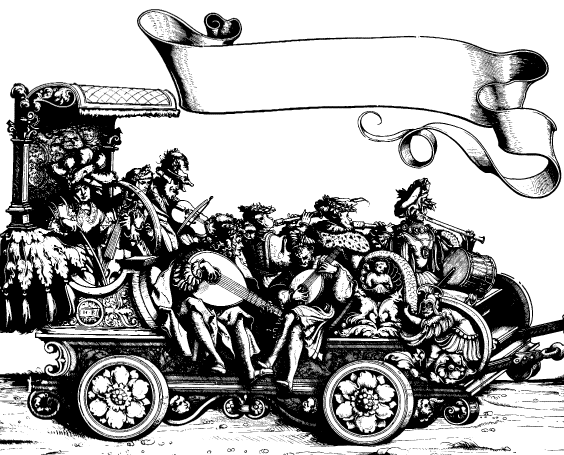

|
When Maximilian died in 1519 the work was stopped and only those parts already finished were published in 1526. Most of the blocks survived until 1883, when the last edition was published by Adolf Holzhausen for the Vienna Kunsthistorisches Museum.
I show details of the two sheets which feature lute-players: 18 and 24. It is quite likely that these show known lutenists of Maximilian's household, another sheet for instance shows a recognisable portrait of his court organist, Paul Hofhaimer. In fact the instructions for sheet 18 specifically mention the master lutenist as "Artus". Has anyone any other reference to him, or indeed does anyone know which one he is?
As has been pointed out by Arne Keller, the pictures show clearly the two different styles of lute right-hand technique, thumb under and thumb out, being used by different players at the same time. In each case the earlier thumb under technique is being used on the larger instrument which is being held in the oud position with the head well down. Thus one might be able use these pictures to date the transition from one technique to the other.
Sheet number 24 shows a pair of lutenists probably playing tenor/treble duets as was common for professional court musicians in the period immediately before this. Keith Polk has done important work on the household expenses of noble families at this time in Germany and Italy which shows that pairings like this were fashionable if you wanted to show your status by artistic display! Some less likely seeming pairings were also common such as lute and sackbut (or trombone)!
Here are the original instructions which Maximilian dictated for each of our two sheets:
18. After them shall be depicted a low little car on small plough wheels: two elks shall draw the car, and a little boy shall be the driver and shall bear the verse inscription.
(Now lutes and viols harmonise
The lutenists, viol players, and the boy shall all be wearing laurel wreaths.
24. Again depict a similar small low car with plough wheels, drawn by a dromedary; a boy shall drive it and bear the leader's verse.
On the car shall be the "sweet melody," that is:
First, a tämerlin; a quintern; a large lute; a rybeben; a fiddle; a small rauschpfeiffen.
(And now melodious music springs
The boy and all of them shall be wearing laurel wreaths.
It is interesting that he uses the term quintern for the small lute as this is the same term and the same pairing with a lute that Agricola shows in 1528. The term quintern probably means a lute tuned a fifth higher (quint) This is the classic treble / ground pairing of the medieval improvising tradition.
|
|
If anyone has any comments about these pictures which differ from or expand
on mine, please do either email me direct or submit them to the lutenet at antispam/lute@cs.dartmouth.edu and I will add them to this page. Do please adjust this address by hand to remove antispam/ |
| Lutes | Bows | |
| History of the Lute | Build your own Baroque Lute | Build your own Renaissance Lute |
Copyright 1998 by David Van Edwards